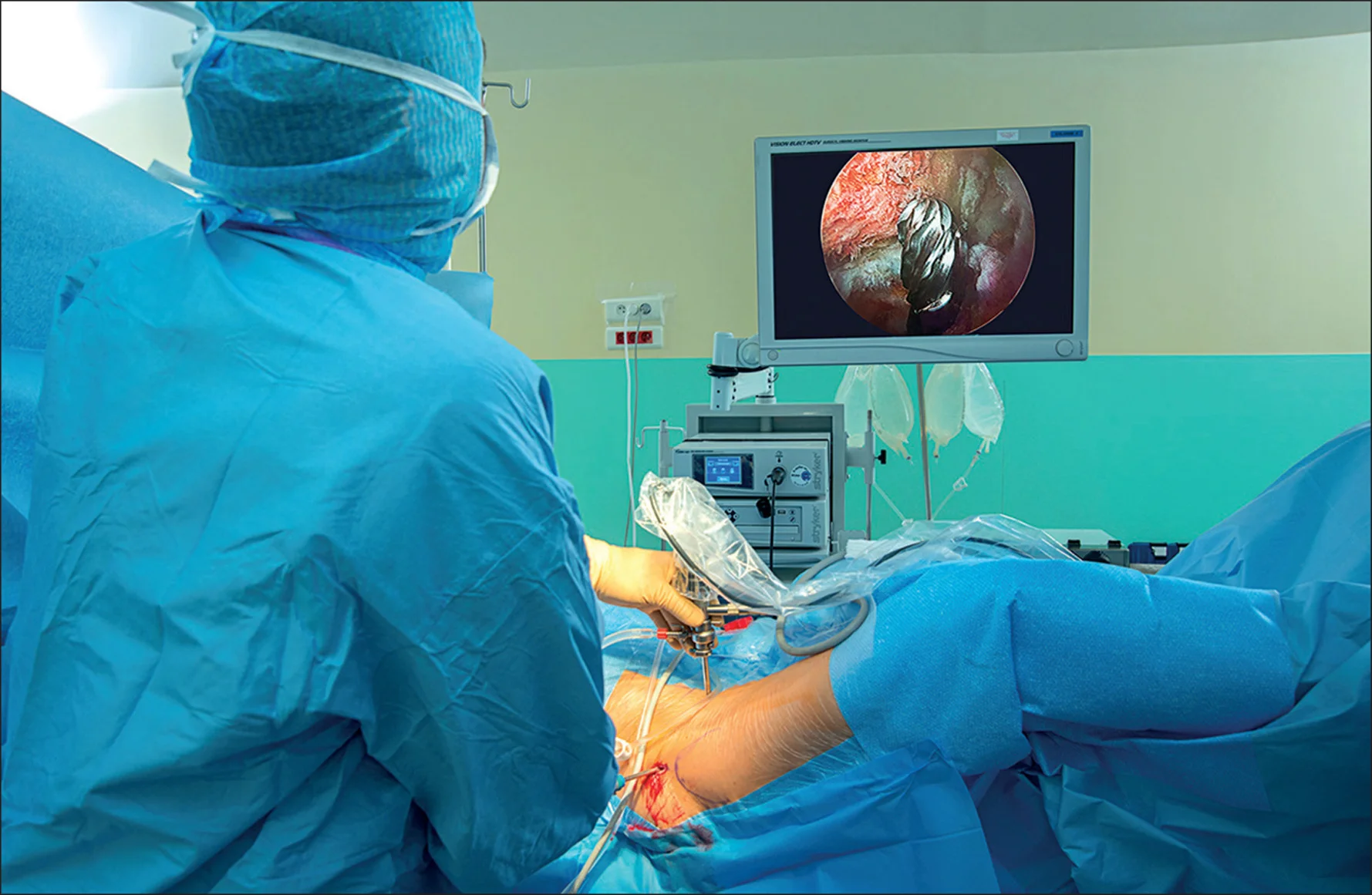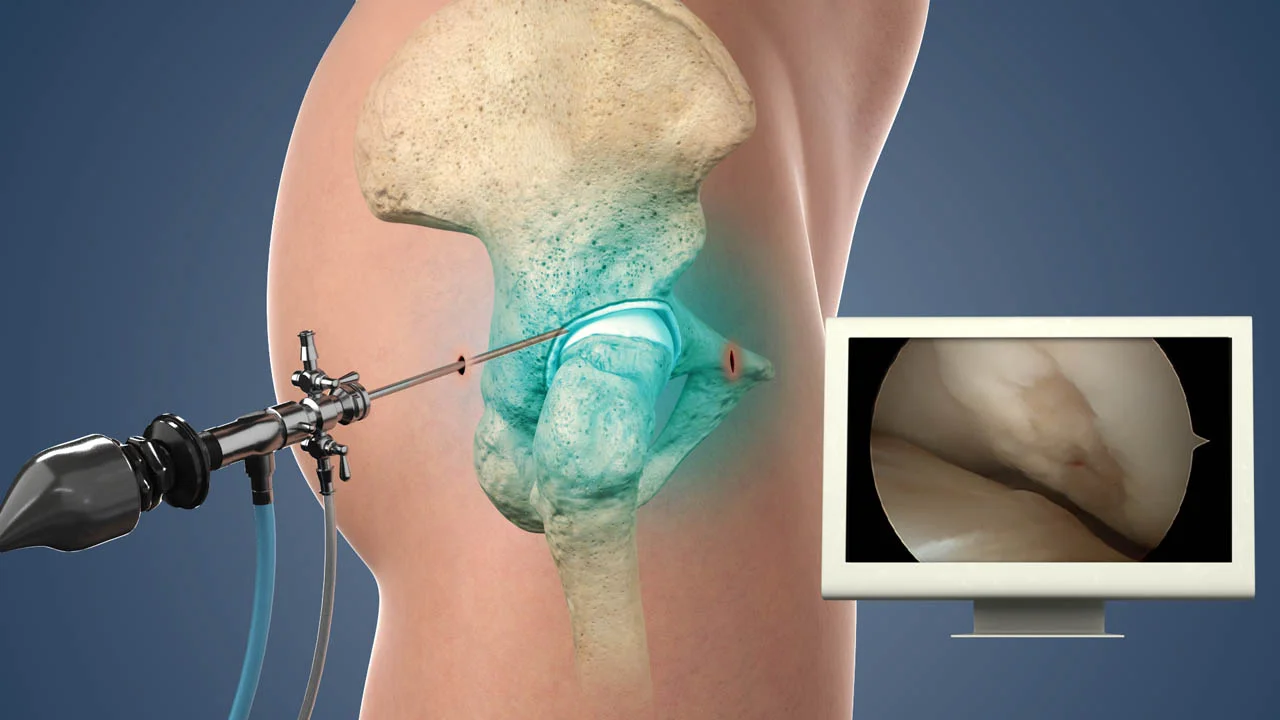
Hip Anthroscopy in Guntur
Best Hip Arthroscopy in Guntur, Andhra Pradesh, India
What is Hip Arthroscopy?
Hip arthroscopy, Andhra Pradesh is a minimally invasive surgical procedure used to diagnose and treat various conditions affecting the hip joint. It involves the use of a small camera, called an arthroscope, which is inserted through small incisions in the hip to visualize the joint and surrounding structures.
During a hip arthroscopy in Guntur, arthroscopy surgeon can examine the hip joint, assess the extent of any injury or damage, and perform corrective or therapeutic procedures as needed. The arthroscope transmits images of the hip joint to a monitor, allowing the arthroscopy surgeon to view the interior of the joint in detail.

When Hip Arthroscopy is performed?
Hip arthroscopy can be used to treat a range of hip conditions, including:
Femoroacetabular impingement (FAI): This occurs when there is abnormal contact between the ball-shaped head of the femur and the socket of the hip joint. Arthroscopy can reshape the bone and remove any impinging structures.
Labral Tears: The labrum is a ring of cartilage that surrounds the hip socket. Tears in the labrum can cause pain and instability. Arthroscopy can repair or remove the damaged labrum.
Hip joint infections: Arthroscopy by top surgeons can be used as a diagnostic tool to assess the extent of infection and guide treatment.
Synovitis: Inflammation of the synovial lining of the hip joint can be treated by removing the inflamed tissue.
Loose bodies: Arthroscopy in guntur allows the removal of loose fragments or foreign bodies within the joint.
Hip joint damage or degeneration: In some cases, arthroscopy may be used to assess the severity of joint damage and guide further treatment, such as hip replacement surgery.
Hip arthroscopy is generally considered less invasive compared to traditional total hip surgery. It often results in smaller incisions, reduced tissue trauma, less postoperative pain, and faster recovery times. However, not all hip conditions can be treated with arthroscopy, and the suitability of the procedure depends on the specific diagnosis and individual patient factors. It is important to consult with best hip replacement surgeon or best orthopaedic anthroscopic surgeon to determine the most appropriate treatment approach for your hip condition in Guntur.
Who is ideal Candidate for Hip Arthroscopy?
The ideal candidate for hip arthroscopy is typically a patient who has hip pain or a specific hip condition that has not responded to Joint Preservation treatments. The decision to undergo hip arthroscopy or hip anthroscopic surgery is based on several factors, including the individual's symptoms, the underlying cause of the hip problem, and the overall health of the patient.
Here are some criteria that may make a person a good candidate for hip arthroscopy:

Hip Pain: The patient should experience persistent hip pain that significantly affects their daily activities and quality of life, despite conservative treatments such as rest, physical therapy, medications, and injections.
Specific hip conditions: Hip arthroscopy is commonly used to treat conditions such as femoroacetabular impingement (FAI), labral tears, hip joint infections, synovitis, loose bodies, and certain types of hip joint damage. If the patient has a confirmed diagnosis of one of these conditions, they may be a good candidate for hip arthroscopy.
Younger age: Hip arthroscopy is more commonly performed on younger patients, typically between the ages of 15 and 50, who have hip problems related to structural abnormalities or sports-related injuries. However, the appropriateness of the procedure depends on individual circumstances, and older patients may also benefit from hip arthroscopy in certain cases.
Good overall health: The patient should generally be in good health and able to tolerate surgery and the subsequent rehabilitation process. Any underlying medical conditions, such as heart disease or lung problems, should be evaluated to ensure they do not pose a significant risk during the procedure.
Recovery After Hip Arthroscopy
The recovery after hip arthroscopy can vary depending on the specific procedure performed, the extent of the hip condition, and individual factors. However, here is a general overview of what to expect during the recovery period:
Immediate postoperative period: After the surgery, you will be monitored in the recovery room until the effects of anaesthesia wear off. You may experience some pain, swelling, and discomfort around the hip joint.
Hospital stay: Hip arthroscopy is often performed on an outpatient basis, which means you may be able to go home on the same day of the surgery. However, in some cases, an overnight hospital stay may be required for closer observation.
Pain management: Your arthroscopy surgeon will prescribe pain medications to help manage any postoperative pain. Follow their instructions regarding medication usage.
Assistive devices: You may be given crutches or a walker to assist with mobility and take weight off the hip joint. The duration of using assistive devices will depend on your surgeon's recommendations and your progress.
Rehabilitation and physical therapy: Physical therapist will guide you through exercises and activities to improve hip strength, range of motion, and stability.
Weight-bearing and activity restrictions: Your arthroscopy surgeon will provide specific instructions regarding weight-bearing and activity restrictions. You may need to limit weight-bearing on the operated leg for a period of time. Activities such as running, jumping, or participating in high-impact sports may be restricted initially.
Gradual return to normal activities: As your hip heals and your strength and mobility improve, you will gradually increase your activity level under the guidance of your best orthopaedic surgeon. The timeline for returning to work, sports, and other activities will depend on your individual progress and the nature of your hip condition.
Follow-up appointments: You will have regular follow-up appointments with your arthroscopy surgeon to monitor your progress, evaluate the healing process, and make any necessary adjustments to your rehabilitation plan.
It is important to note that not all hip conditions can be effectively treated with arthroscopy, and the decision to undergo the procedure should be made in consultation with best anthroscopy surgeon in Guntur who specializes in hip arthroscopy. The surgeon will assess the patient's specific condition, symptoms, and medical history to determine the most appropriate treatment approach.
.webp)
.webp)





